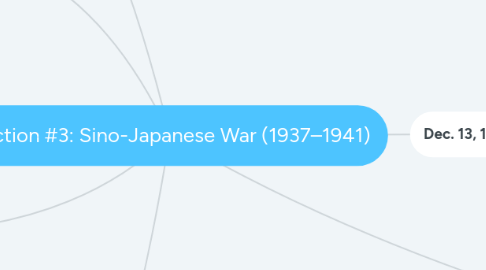
1. July 7, 1937 - Sept. 9, 1945: 2nd Sino-Japanese War
1.1. Early Days of the War
1.1.1. GMD had moved capital to Nanjing (Nanking)
1.1.1.1. Fell to Japan in December of 1937
1.1.2. Prince Konoe called on army to “Annihilate” the Nationalists
1.1.3. China appealed to League
1.1.3.1. To no avail
1.1.4. China’s Second United Front
1.1.5. Jiang was focused on CCP throughout early ‘30’s
2. 1927 - 1949: Chinese Civil War
2.1. ‘36 - Jiang is kidnapped by warlord that was supposed to be fighting CCP
2.1.1. Convinces Jiang to change priorities
2.2. 1936 - Civil War suspended
2.2.1. Turns to “War of national resistance”
3. July ‘41: Imperial Conference held by Japan’s government
3.1. Japan forces move into South Indo-China
3.1.1. US responds w/ total ban on oil, iron, aircraft to Japan
3.1.2. All Japanese assets frozen in US
3.2. Negotiations to halt embargo take place throughout ‘41
3.2.1. US demands Japan withdraw from China + open trade
3.2.2. Japan wants to expand into Dutch East Indies, Philippines, & British Malaya
3.3. Japan’s Navy presents plan calling for opening hostilities by Oct. ‘41
3.3.1. As talks breakdown, Japan decides they need to wipe out US naval fleet in Pacific
4. Dec 7, 1941: Attack on US base at Pearl Harbor
4.1. US Losses
4.1.1. 2,403 Casualties
4.1.2. 1,178 Injuries
4.1.3. 90% of mid-Pacific air & sea power destroyed or damaged
4.1.4. Aircraft carriers out on maneuvers
4.2. Response to Attack
4.2.1. December 8th - US declares War on Japan
4.2.2. FDR’s speech to Congress
4.3. Japanese Response
4.3.1. Expands the “Greater East Asia War” which included;
4.3.1.1. The “Japan-China Incident”
4.3.1.2. Conflicts with the UK
4.3.2. Japan assumed attack would lead to easy victory
4.3.2.1. US only temporarily inconvenienced Leads to war of attrition
5. Control (Tojo’s group) advocated “strike-South policy” - expansion in Asia and Oceania
6. Dec. 13, 1937: Nanjing Massacre
6.1. 7 Weeks
6.1.1. Brutal rape, torture, robbery, murder by JP soldiers upon innocent Nanjing civilians
6.1.1.1. Destroyed Japan’s international credibility
6.1.1.1.1. (What little was left)
6.1.1.2. Japanese nationalists today deny the extent of the atrocities
6.2. Course of the War
6.2.1. Chinese were lacking effective weapons and industrial support
6.2.1.1. Refused multiple offers to “join” Japan in ‘38 (fought on)
6.2.2. Japan had to keep pushing further into interior
6.2.2.1. Fighting a two-front war
6.2.2.1.1. Mao in NW and Jiang in Chongqing
6.2.3. By 1940, Japan had 750,000 ground troops in China
6.2.4. Even w/o international opposition, they couldn’t wrap the war up quickly
6.2.4.1. They were never really planning for a full scale war with China, who wasn’t giving up easily
6.2.5. Tried to live off the land and install puppet government
6.2.5.1. Wang Jingwei
6.2.6. Increased Domestic Control to support War Effort
6.2.6.1. State Shintoism
6.2.6.2. Use of Kempeitai
6.3. U.S and Japanese Relationships
6.3.1. Early 1900’s - US takeover of Philippines, Cuba, Hawaii, Guam
6.3.1.1. Social Darwanism
6.3.2. US tried to limit Japan’s territorial gains after Russo-JP War
6.3.3. US policy of Dollar Diplomacy in the Pacific
6.3.4. Conflict over Treaty of Versailles
6.3.5. US Isolation & new immigration policy
6.3.6. US recognition of Nationalists in China
6.3.7. Relations relatively stable until 1930’s
6.4. The War in the Pacific: Politics
6.4.1. Remember: Imperial Way Faction of military Lost out to Control Faction after the failed coup in Feb. ‘36
6.4.1.1. Imperial Way advocated “strike-North” policy
6.4.1.2. Japan’s policy of Hakko ichiu formally endorsed in early ‘30’s - “eight corners of the world under one roof” - Japan embraces “Asian Monroe Doctrine”
6.5. The War in the Pacific: Economics
6.5.1. Mitsui and Mitsubishi work with military to build up heavy industry
6.5.2. Everyone has economic crisis in 1930’s
6.5.3. Oct. ‘37 - FDR gives “Quarantine Speech” - suggests US should help countries attacked by aggressive nations
6.5.4. ‘37-’39 - US is giving loans to China and trading military equipment + oil with Japan
6.6. Japan and European Democracy
6.6.1. Anti-Comintern Pact (Nov. ‘36)
6.6.1.1. Ger, IT, JP would consult on measures to “safeguard their common interests”
6.6.2. Tripartite Pact Sep. 1940 Berlin
6.6.2.1. IT, GER, JP
6.6.2.2. Confirms intentions for all 3 to establish “new orders” in their respective regions
6.6.3. Soviet-JP Neutrality Pact (Apr. ‘41)
6.6.3.1. Designed to prevent two-front war
6.7. Path to Pearl Harbor
6.7.1. ‘38- FDR at odds with Isolationists
6.7.1.1. He is gaining power
6.7.1.2. Uses Neutrality Act to provide more support for Nationalists
6.7.1.3. US Gunboat - The Panay (December 38th)
6.8. 1940 - Militarists Take Control
6.8.1. Prince Konoye returns as PM
6.8.1.1. Fails to control military power
6.8.2. Multi-Party Rule Suspended
6.8.3. Gen. Tojo will be PM by Oct. 41
